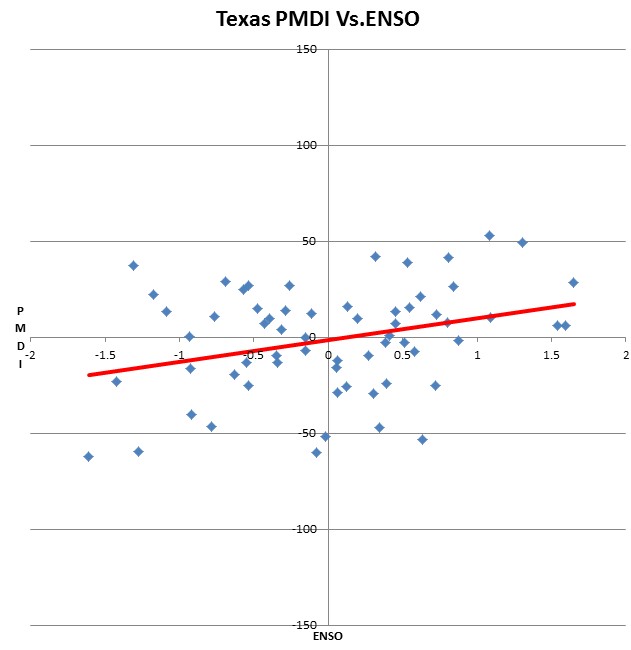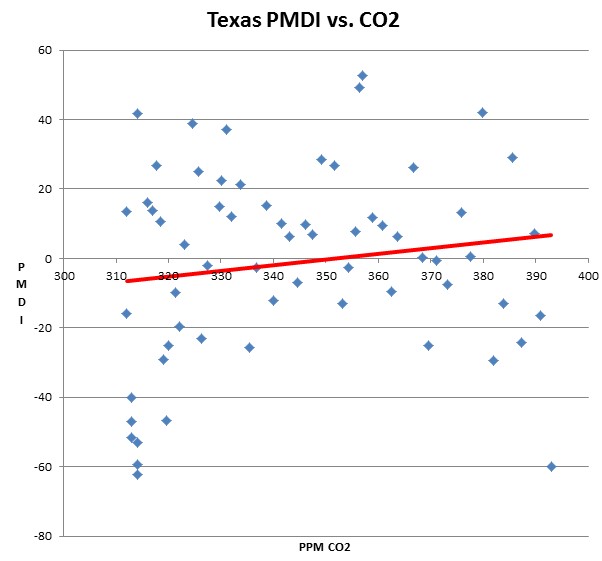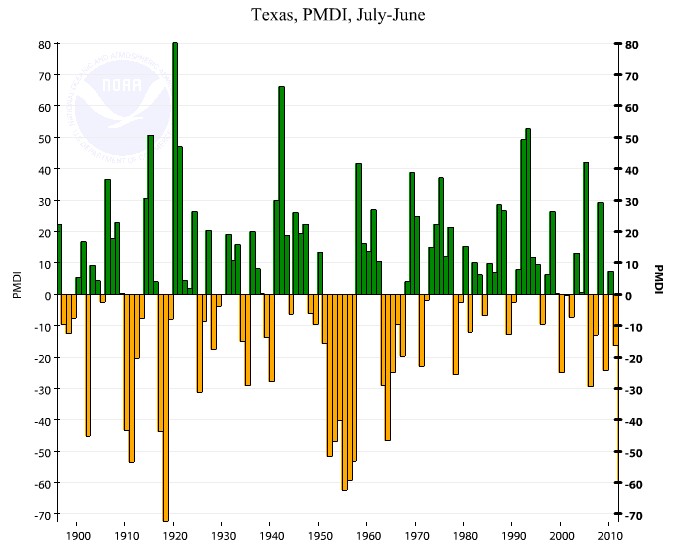Andrew “Permanent Drought” Dessler has been telling us that drought in Texas is due to CO2. So I plotted PMDI vs CO2, and PMDI vs. ENSO.
Negative PMDI indicates dry conditions, and correlates quite well with La Nina. Texas has never been dry with ENSO above 1.0 (i.e. El Nino)
On the other hand, Texas drought shows anti-correlation with CO2. As CO2 has increased, Texas has had fewer droughts. What this tells us is that Dessler has never done any actual research on this subject using actual data. It took me 10 minutes to gather the data and do this analysis.
PMDI data from here
YEAR ENSO CO2 PMDI 1950 -1.09 312 13.38 1951 0.052083333 312.2 -15.74 1952 -0.0165 312.8 -51.73 1953 0.343166667 313.3 -47.02 1954 -0.920166667 313.6 -40.14 1955 -1.608583333 314.1 -62.38 1956 -1.27675 314.3 -59.37 1957 0.633583333 314.5 -53.17 1958 0.805833333 314.7 41.68 1959 0.129916667 315.97 16.18 1960 -0.284416667 316.91 13.76 1961 -0.258416667 317.64 26.86 1962 -0.76275 318.45 10.54 1963 0.058833333 318.99 -29.11 1964 -0.787833333 319.62 -46.75 1965 0.719083333 320.04 -25.04 1966 0.273083333 321.38 -9.79 1967 -0.63125 322.16 -19.71 1968 -0.311916667 323.04 3.89 1969 0.531083333 324.62 38.8 1970 -0.570416667 325.68 24.89 1971 -1.423666667 326.32 -23.02 1972 0.877666667 327.45 -1.98 1973 -0.475333333 329.68 15.02 1974 -1.177166667 330.18 22.36 1975 -1.30675 331.08 37.03 1976 -0.112 332.05 12.13 1977 0.621416667 333.78 21.33 1978 0.122583333 335.41 -25.73 1979 0.514333333 336.78 -2.74 1980 0.547083333 338.68 15.22 1981 0.06125 340.1 -12.06 1982 1.092833333 341.44 10.1 1983 1.593416667 343.03 6.16 1984 -0.150333333 344.58 -6.88 1985 -0.397833333 346.04 9.81 1986 0.449916667 347.39 7.01 1987 1.64775 349.16 28.57 1988 -0.53375 351.56 26.63 1989 -0.551833333 353.07 -12.98 1990 0.382166667 354.35 -2.6 1991 0.800416667 355.57 7.84 1992 1.3045 356.38 49.19 1993 1.084833333 357.07 52.74 1994 0.724 358.82 11.82 1995 0.195666667 360.8 9.52 1996 -0.34875 362.59 -9.64 1997 1.542 363.71 6.23 1998 0.842333333 366.65 26.28 1999 -0.93075 368.33 0.25 2000 -0.532916667 369.52 -25.08 2001 -0.156166667 371.13 -0.47 2002 0.578083333 373.22 -7.39 2003 0.450416667 375.77 13.12 2004 0.409833333 377.49 0.63 2005 0.317083333 379.8 42.08 2006 0.301333333 381.9 -29.5 2007 -0.34025 383.77 -13 2008 -0.688416667 385.59 29.19 2009 0.390333333 387.38 -24.34 2010 -0.430666667 389.78 7.27 2011 -0.927416667 391 -16.42 2012 -0.081666667 393 -60.03





@Steve: Speaking of junk science, check out the errors in GCM’s:
“A paper published today in the Journal of Geophysical Research finds that current global climate models make “very large” errors in determining solar radiation at the surface of the Earth “due to ignoring the effects of clouds.” According to the authors, these very large errors can exceed 800 Watts per meter squared, which by comparison is about 216 times more than the alleged effect of doubling CO2 concentrations [3.7 W m-2].”
http://hockeyschtick.blogspot.ca/2012/07/settled-science-update-climate-models.html
Do clouds affect the weather?
I have to seriously question the accuracy of your CO2 and Texas PDMI plot. You never specify whether this is monthly or yearly PDMI and CO2 data. I have to assume it is monthly, but which month?.
The Mauna Loa Data started in 1958 with the lowest CO2 concentration of around 313 ppm: http://www.woodfortrees.org/data/esrl-co2
Meanwhile here is the June Texas PDMI index over time shows that in 1958 it was already positive around 3.61: http://www.ncdc.noaa.gov/temp-and-precip/time-series/index.php?parameter=pdsi&month=6&year=2012&filter=1&state=41&div=0
From that raw monthly (June) Texas PDMI data, I don’t see any values that fall below -5 after 1958 that would occur when CO2 concentrations were in the 313-315 range. But your plot seems to indicate that relationship happened.
Then I see June Texas PDMI values that fall to around -4.7 in 1996 when CO2 concentrations were around 360 ppm that also doesn’t show up in your plot. So how can anyone believe the accuracy of this chart and why didn’t you link to the raw data, including the corresponding years that this relational data is supposedly coming from?
When I actually take the data from these two data sources I get this:
CO2 (ppm) PDMI
1958 315.24 3.61
1959 315.97 1.12
1960 316.91 1.02
1961 317.64 2.54
1962 318.45 -1.63
1963 318.99 -3.99
1964 319.62 -3.54
1965 320.04 -1.09
1966 321.38 1.08
1967 322.16 -4.69
1968 323.05 3.63
1969 324.62 2.98
1970 325.68 -0.12
1971 326.32 -4.97
1972 327.45 -0.16
1973 329.68 2.99
1974 330.18 -2.09
1975 331.08 3.97
1976 332.05 0.19
1977 333.78 -0.40
1978 335.41 -3.12
1979 336.78 2.73
1980 338.68 -1.26
1981 340.10 1.45
1982 341.44 1.52
1983 343.03 1.48
1984 344.58 -2.48
1985 346.04 2.38
1986 347.38 1.10
1987 349.16 4.54
1988 351.56 -1.19
1989 353.07 0.84
1990 354.35 -0.57
1991 355.57 1.10
1992 356.38 6.18
1993 357.07 4.57
1994 358.82 -0.66
1995 360.80 2.36
1996 362.59 -4.66
1997 363.71 3.98
1998 366.65 -2.97
1999 368.33 1.75
2000 369.53 -3.02
2001 371.13 -1.04
2002 373.22 -1.68
2003 375.77 -1.12
2004 377.49 2.32
2005 379.80 -1.20
2006 381.90 -5.43
2007 383.76 4.20
2008 385.59 -2.41
2009 387.37 -4.27
2010 389.78 2.27
2011 391.57 -6.24
2012 394.99 -3.81
which produces a a downward sloping ling with the equation y=-0.0226X + 7.8452 and an R2 of 0.0324. Nothing even close to what your chart shows and completely runs counter to your conclusions.
It sounds like you are challenging the data. Are you really sure you want to go there? I will do a special post dedicated to making fun of your comment if you like.
http://www.youtube.com/watch?v=TcxpbhM0DaA
Just asking for you to provide the raw data that you used since it wasn’t voluntarily given and doesn’t match the raw data in my data links.
The data and links are there.
They weren’t there originally along with the actual data when I place my comment. At least I understand where they came from now.